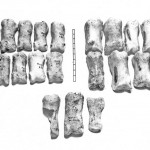Abrigin breeds
Human activities of the man at all the times was aimed primarily at providing himself with the means necessary for the existence and maintenance of life support systems, i.e. water, food, clothing, shelter and warmth.
The bones of animals in greater or lesser quantity are found in almost all the archaeological monuments. And, of course, they always forced archaeologists to think of those who these bones had be belonged, animals they were and how they had got to the settlement.
The reasons why the bones of animals could get in the cultural layer, are surprisingly different and reflect various, sometimes unexpected aspects of human life. The clearest to us the use of animal meat as food. The least is a ritual burial of the whole carcasses of sacrificial animals or their parts.
In the settlements of the Abrau peninsula among the kitchen waste mainly are the bones of bulls and cows, pigs, sheep and goats. Calculations showed that beef meat was mainly in the diet of the population of the peninsula throughout all antiques times. According to some monuments beef meat ranged from 50% to 80% of all meat products.
Preference to the beef in a meat diet reflects an enormous economic value of the cattle for the tribes of the Northwest Caucasus. Study of age of slaughtered for meat bulls and cows, measurements of their bone and morphological features allowed the archeozoologists to reveal the forms of exploitation of this kind in the antiquity. So during the excavations of the Krasnaya Batareya settlement they discovered a cow or bull phalanx with typical signs of draft animals. There is no doubt about the appointment of the majority of dairy cows. At the same time surprise was caused by extremely small size reconstructed of these animals. So the size in wither of almost 70% of all cows and bulls in the settlement Myskhako and the Rayevski mound hardly reached one meter. But there were instances of even smaller size – 87 cm in to wither.
A description of modern native breeds of the cattle in the Caucasus is a key to understanding of these extremely small size of the cattle in ancient settlements on the Abrau Peninsula. Most of today’s professionals in the field of animal husbandry indicated that the «ecological and geographical factor» in forming the size and productivity of nature cattle in the Caucasus, forming some breed groups ‒ mountain, plains and steppes. Cows and bulls of the mountain shape with the smallest body size in adult animals and the weight of only 130‒200 kg, yet «tirelessly cover long distances up steep climbs and descents during a day».
Today, it can be stated that such native breed groups existed in the North Caucasus already in the antic times. The remains of bones of animals in the mountain shape (or breed) having the lowest height in wither and a maximum weight of 200 kg, predominate in the collection in Myskhako. Of course, a direct genetic link between the cattle of ancient times and modern mountain breed of the Caucasus may not be. But both, of course, are the result of successful adaptation to specific environmental conditions of the mountainous country. The main factor in shaping the size is small livestock of almost the year-round of its living on meager grazing slopes.
(Catherine E. Antipina).




